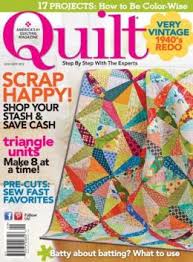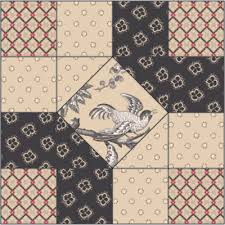
This is a review of the August/September 2013 issue. I read it while I was on the plane to Seattle. I bought this one at the same time I bought Fast Quilts. I think I bought it because the cover is fresh and cheerful. If I have read this magazine before, it has been awhile.
This magazine has articles as well as patterns. Near the beginning is a “Readers Top Tips.” I have heard many, many tips in my travel through the quiltmaking landscape, but occasionally is something that sparks my interest. We can always learn.
In this issue, a reader suggested that cutting a 2.5″ strip off each piece if yardage quiltmakers wash and iron might be a good idea. I am cutting pieces anyway so why not? One reason that I might not want to do that is that I might not want to make a jelly roll quilt. Also, if I only buy a half yard of a fabric, cutting a 2.5″ strip off of it will reduce the width.
However, in addition to using a collection of jelly roll strips for patterns such as those from the Lintott girls, such as Jelly Roll Quilts or Layer Cake, Jelly Roll & Charm Quilts, or from Kimberly Einmo’s Jelly Roll Magic, the tip suggests giving them as a gift. I like this idea. Not many of the friends to whom I give gifts make jelly roll quilts, but it is an idea.
Another article, or tip, is called Scrap Savvy. It suggests cutting your scraps from a project into usable sizes. Pam goes into her methodology for this type of project on her site and in her podcast. I think it is a good idea to cut scraps into usable sizes. For me, I am not sure what the usable sizes would be.
This issue includes a column by Kaffe Fassett [enough said]. I know he comes from knitting and needlepoint, which, I think, gives him a briader perspective. I’d like to see his essays on design and color compiled into a book.

An interesting couple of pages showed two different blocks. I think the idea was to encourage stash building (like any of us need that!), but I think putting blocks on a page without a quilt allows the readers’ imaginations to flow and inspire some interesting possibilities.
I am always interested in new tools, so the page full of the sparked my interest. I liked the idea of the Bloc_Loc rectangular ruler (website with video). I think it is interesting how the ‘locking mechanism’ fits on the seam line rather than the mat or somewhere else.
A Guide to Batting is covered in this issue as well. The article is laid out in a very cute and appealing way, but, ultimately, poorly done. The author did not talk about characteristics consistently across products. I wanted to know which batting (aside from poly) would shrink the least when washed. I couldn’t tell from this article and plan to go back and look when I am not quite so tired. I did find out that there are quite a number of new battings that I haven’t heard of. There was was also a glossary of terms related to batting, which was helpful.
You might remember my Triangle Technique. This issue has a chart showing how to make triangle squares 8-at a time the way my TT tutorial shows. If you read my tutorial you will know that others thought up this technique. I added to the knowledge store by creating a chart showing sizes. The tutorial in this issue gives you the math formula showing how to calculate for different sizes. No, I am not going to tell you what it is; you have to buy the magazine. My tip, though, is go a bit larger than they say, so you have room to trim to get absolutely perfect HSTs.
The primary focus of the magazine is on the quilt patterns. There are 16 projects in this issue. The directions and supplies are generally contained in 2-3 pages.
I liked the Floating in Air pattern, because of the scrappy / charm selection of squares. It doesn’t look chaotic. TFQ and I used to exchange 4″ squares and this quilt would work really well with those charms.
Looking at the Stars & Stripes pattern (guess the color scheme) would look in other colors. I realize this pattern was designed for a specific holiday, but I would like to see it in a different colorway. Would the design translate successfully into different colors? Could the appliqued stars be replaced by eggs for Easter or moons for worship of Artemis?
I thought the Falling Stars quilt (pg.67) was an interesting layout. I don’t know why the designer used an appliqued Sawtooth Star when those stars are so easy to piece. Perhaps the unbroken look of no seam lines?
Blueberry Parfait (pg.74) has a great name. The pieces are so large that it is hard to see any sort of design unless the quilt is spread out flat. Once flat it has a strong diagonal design. The scale of the pieces are too big for me. I think this design could be scaled down just a bit and have equal impact.
I haven’t made the quilt, but glancing through the directions gave me the impression that there was a lot of waste in the construction techniques.
The quilt on page 82, Galileo’s View, really made me wonder.The quilt has blocks, but the blocks work together to make an overall design. It is marked intermediate and I can’t tell why. The blocks are large and simple. The sashing is thin and the blocks have to be placed in a certain way to achieve the overall design of the quilt. Other than paying attention to layout, I don’t know why anyone but the very fresh beginner would have any problem piecing this quilt.
Overall, there are quilts in this magazine for everyone. All tastes and a lot of styles are covered, even the 1990s, Asian, floral and, of course, modern and classic.
**Nota Bene: I am still creating posts off of my phone, so pardon the weird, uncropped photos and any typos. We’ll get back to regularly scheduled programming soon.